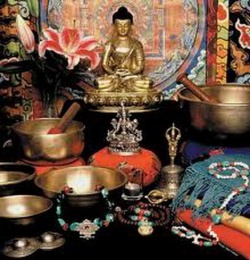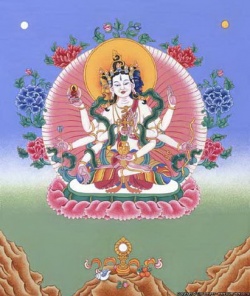Dhāraṇī
dhāraṇī (陀羅尼). Usually in the Form of a long Mantra, it means Total retention (總持). With excellent memory, Samādhi, and Wisdom, A Bodhisattva has the inconceivable Power to unite all Dharmas and hold all meanings. He can not only retain all good Dharmas but also stop the rise of Evil Dharmas.
Dharani is a multivalent term, referring at once to:
- mnemonic device of Dharma (as apparent from its etymological root dhr.i - meaning 'to hold, bear or support (of rafters)' (also per Tibetan gzun.s) - indicating the mnemonic Dharani contains/supports abbreviated Knowledge, until a cypher unpacks the meaning) - charm words, or magic spells (as seen in the Chinese translations [as opposed to transliteration] 咒語 (spell Language?) or 真言 (true words?).)
Dharani are also called 'Dharma-Sarira' - or [textual] Relics of the Dharmakaya - or, [textual] Relics of the Buddha's teaching Body (Dharmakaya). In this Light, Dharani possess the powers of bodily Relics of the Buddha's corporal Body.
Dharani can refer to a speech act, a textual performance, a coordination of [spatial, aural/oral, visual reality into a sacred Form. It is a series of syllables - of uncertain [any?] semantic value - an arrangement of sacred syllables. It may have begun as a 'table of contents' for Buddha's teachings. Perhaps after passing through the mouths and ears of many Monks, Dharani became oral rosaries. Condensed, hardened fragments of The Buddha's corpus, twirling past the lips of the faithful - the soundtrack of working Miracles.
Many practices arose to instatiate and celebrate the charm words of The Buddha's Dharmakaya. Dharani are recited in daily liturgy. Dharani reproduction in 'clay seals' in medieval Magadha (India) is attested in Xuanzang's journal; Boucher says it was devotion to The Buddha's verse of Interdependent Origination ("All Dharmas arise from a cause. I have explained this cause. When the cause is
exhausted, there is cessation. I have produced such a teaching." "He who sees the Pratityasamutpada see the Dharma; he who sees the Dharma sees The Buddha.") See, "Sutra on the Merit of Building a Stupa Spoken by The Buddha." Empress Wu sponsored woodblocks to print quantities of sacred syllables; the oldest surviving printed matter in the World was a Dharani connected to Empress Wu, discovered in a Stupa in Korea. The million wooden Stupas of Horyuji, Japan, housed copies of several Dharani produced around the same Time.
There are many Dharani. They each have different powers and capacities. Accordingly, they are each worshipped in distinct ways. Such powers and means of worship are usually explicated in the Sutra section of a 'Dharani-Sutra'. In these Sutras, The Buddha describes the Power of the Dharani, explains how to worship it, and then proclaims the secret syllables for the sake of Sentient beings.
Paul Copp wrote a PhD dissertation at Princeton about one of the most prevalent Dharani. This Dharani is best activated by the carving of its syllables into stone. Stone 'Dharani pillars' are found in many temples around China.
And in the 10th century in eastern China, the king of Wuyue cast "84,000" Stupas and printed Dharani-Sutra to entomb in each of them. This Asokan act populated the landscape with Dharma. Because that Dharani is activated by its being entombed in a Stupa, the king cast bronze and iron 'Asoka pagodas' to encase scrolls of the printed Dharani-Sutra. Throughout the 20th century, these thousand year old 'tombs of textual Relics' were discovered in Eastern China, often with the Dharani-Sutra still intact within.
As the central masterpiece of this production of Dharani-Sutra worship, the King of Wuyue constructed an enormous stone Stupa over the site where was buried a gold-plated pure-silver 'Asoka pagoda' - a Mysterious treasure recently excavated. Moreover, part of each baked brick used to build the walls was a narrow hole on one side. A copy of the Dharani-Sutra was squeezed into these holes (sometimes also with
a rubbing of the (elusive pure-silver?) 'Asoka pagoda'.) Thus, every brick used in the construction of the walls of the pagoda was enchanted with the Power of an 'Asoka pagoda' - every one contained a Dharani. This Way, running through each of the bricks like a net of pearls, a web of
protection, more than the sum of its parts, coursed through the very materials of the Leifeng Thunder Peak pagoda of West Lake, Hangzhou. The entire Thunder Peak pagoda was a vehicle for the activation of this Dharani.
When the earthy remains of the decrepit Thunder Peak pagoda collapsed in a powerful storm in 1924, amongst the shattered bricks was discovered hundreds of scrolls of the 975 edition of the Dharani-Sutra, printed by the King of Wuyue. Eerily prescient, the Sutra section of the Dharani-Sutra describes a decrepit site where once a magnificent Stupa stood; at this site The Buddha reveals the Dharani that is the
lexical embodiment of all of The Buddha's profound truths. In 1924, at the decrepit site of what once was Thunder Peak pagoda, that very Dharani spoke by The Buddha was (again) revealed. If only Vajrapani had been there to interpret and explain The Buddha's teaching of Impermanence through the Revelation of the Leifeng Dharani (doc 1mb). What did this Dharani say?
In construction/renovation of the Ideal Hotel in downtown San Diego during 2008, a free-translation of this Dharani was printed. Printing it, trimming it, and creating a scroll - the Dharani (along with the enduring Name of the cosmic Buddha) was placed amongst the rafters of the building, sealed behind dry-wall. Good intentions lay behind every piece of sheetrock in the Dharma center, as embodied in the Red lotus Dharani.
See also: Dharani

